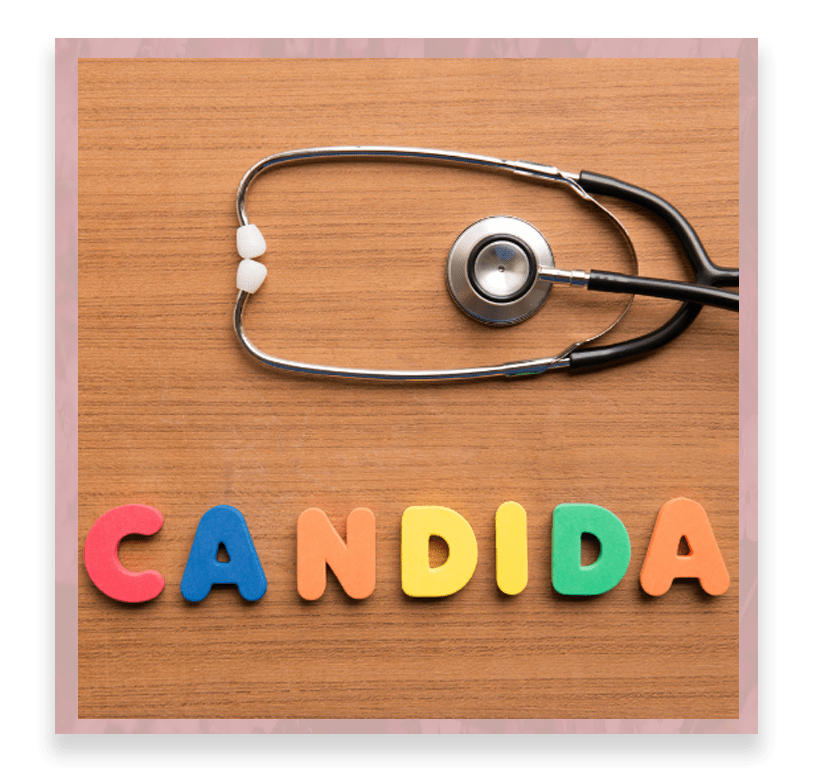Candida Clinic
Welcome To The Candida Clinic
CANDIDA - What is it? What are the symptoms?
We can eradicate it through a nutritional detox program.
Take the complimentary Candida Screening Test below


Candida is an over-infestation of yeast in the body. It invades the brain and every tissue of the body and it can be just as devastating.
Candida grows and lives on what you eat.
It makes your body crave what it needs, and it rampages until you eat it. For this reason, candida is difficult to get rid of, but it can be eradicated if proper steps are taken.
Candida may occur alone or in combination with fibromyalgia. About 80% of those suffering from fibromyalgia also have candida. Both of these syndromes are auto-immune disorders. Take the touch point test to determine if your pain and fatigue may be caused by fibromyalgia. If you suspect fibromyalgia, you must also screen for candida. we always screen for both syndromes before determining a program. For a candida screen, take the self-test above.
If your score leads you to believe that you may have candida, request a candida test from a holistic practitioner, which may include a blood test, stool test, ear candling, or written screening. Most people have either one condition or the other. For those with both fibromyalgia and candida, the candida must be treated before the fibromyalgia.
Candida (albicans) is one of the many different types of yeast. Yeast cells are able to grow on the surface of all living things and occur virtually everywhere. The fact is, we breathe, eat, and drink them daily. Because they are part of our daily lives, we all have yeast growing in our skin, on other body surfaces, and in our intestines. Normally our bodies’ defense systems keep the total number of yeast cells under control, and so candida colonies in our intestinal tract are nothing to worry about. However, poor nutrition or a sluggish or impaired immune system weakens the body’s ability to fight off yeast. Stress and environmental pollutants can also play a role in reducing the body’s control over candida. When this happens, yeast colonies grow rapidly and candida may result.

Causes Of Candida
There are over 900 species of yeast, and candida albicans is a major one found in the human body. In some ways, it is very much like the yeast used in bread. Scientists are not sure why yeasts are in our bodies or what their exact functions are the only thing we know for sure is that they help decompose and recycle our bodies when we die. If they multiply too rapidly in our bodies, they begin their job prematurely.
- A number of conditions can lead to candida. Steroid drugs (such as cortisone), birth control pills, and the long-term use of antibiotics (such as those used to control acne or various bacterial infections) can invite the problem. Such antibiotics can reduce the number of beneficial bacteria that normally help to keep the yeast under control. Antibiotics kill not only the bad but also the good bacteria in the body, Good (or friendly) bacteria work like a police force or army, keeping the invading yeast from spreading through the body. As long as the body maintains a sufficient number of helpful bacteria to counterbalance the effects of harmful bacteria (or yeast), the body remains healthy. Antibiotics kill the weakest link and then the next weakest. The strongest bacteria survive and re-multiply. When an antibiotic or a specific candida drug (such as Monistat 7, cream, or suppository) are used to solve a problem, the yeast and bacteria left to become a stronger strain. We have created new strains and a new generation of mutant and very difficult to eradicate virus, bacteria, and yeast. The drug companies are then creating stronger antibiotics and antifungals to kill the stronger mutant yeast and bacteria. The more chemical stuffers for symptoms that a person uses, the harder it is and longer it takes for the body to naturally eradicate the candida. Microbial resistance to antibiotics has become a major health crisis. Antibiotic drugs also suppress immune cell production and diminish the strength of the immune system as a whole.
- Poor nutrition or a sluggish or impaired immune system weakens the body’s ability to fight off yeast. Stress and environmental pollutants can also play a role in reducing the body’s control over candida. When this happens, the yeast colonies grow rapidly, and candida my result.
- Alcohol, caffeine, stress, and aging all destroy friendly bacteria in the system.
- Sugar, gluten, and meat encourage harmful bacteria in the intestines.
Effects Of Candida
- When the yeast is in an overabundance, there may be local yeast infections in the mouth (thrush), gastrointestinal tract (gas), vagina (yeast infection), urinary tract (bladder/kidney infection), prostate gland (prostate troubles), skin (hives, rashes), fingernail, or toenail (fungus of the nail bed).
- Too much yeast can cripple the immune system, causing chronic viral and bacterial infections or allergies. Yeast can damage the intestinal wall, allowing food particles and toxins to enter the bloodstream. The body then produces antibodies to fight these foreign substances and typical “allergic” reactions may occur, such as eczema and hay fever, along with headache, dizziness, heart palpitations, anxiety, fatigue, and muscle aches.
- There may be changes in the cells that contribute to the candida condition. Yeast by-products or exhaust are two very toxic substances: ethanol and acetaldehyde. The set two toxins in turn alter the ability of our cells in the following ways:
- Red blood cells have difficulty passing into small capillaries. This can cause fatigue, dizziness, muscle aches, or headaches.
- White blood cells have trouble enveloping bacteria and foreign material, thus, the body has trouble fighting infection.
- Sugar has difficulty passing through cells. Insulin cannot do its job properly, causing low blood sugar and often weight gain.
- Thyroid hormones have trouble passing through cells, which causes the metabolism to slow down, often causing low body temperature (cold hands and feet), fatigue, and intolerance to cold.
- Minerals have trouble passing through cell walls, causing fluid retention and electrolyte imbalance.
- Messages passed from one cell to another have difficulty. This can cause muscle and nerve problems.
- Enzymes are destroyed. Enzymes are the chemical helpers in the body that help to build, break down, and produce energy and heat. Yeast toxins can inactivate or destroy some of the enzymes and can result in slowing all the functions of the body. For example enzymes help break down sugar stores to help keep the blood sugar at ideal levels; when yeast overgrowth destroys enzymes, abnormally high or low blood sugar levels may develop.
Symptoms Of Candida
- Allergic reaction; congest nose, hives, headache, dizziness, diarrhea, weakness, cramps, arthritis, irritability or depression, increased sensitivities to foods or chemicals.
- Gastrointestinal problems; gas, bloating, abdominal pain, gastritis, gastric ulcer, heartburn, diarrhea, constipation, spastic colon.
- Respiratory problems; frequent sore throat, mouth or canker sores, sinus infection, bronchial infections, chronic cough, asthma.
- Cardiovascular problems; palpitations, rapid pulse rate. (Candida does not directly effect the heart but rather the hormones regulating the system.)
- Genitourinary problems; yeast infections, itching or burning in the vagina or prostate, urinary burning, frequent urination, lack of bladder control, bed wetting, menstrual cramping, PMS.
- Musculoskeletal problems; muscle weakness, night leg pains, muscle stiffness (especially next and shoulder), slow reaction time, poor coordination, poor motor skills, falling, tendency to drop things. (Yeast impairs cells from receiving nutrients and eliminating waste and also nerve/muscle sending patterns.)
- Skin infection; usually rash type in nature, typically under the breasts, groin area, diaper rash, hives, etc.
- Central nervous system problems; headache, sinus headache, tension headache, migraines, low blood sugar headaches, rapid blood sugar changes.
- High levels of stress hormones can cause anxiety, irritability, moodiness, restlessness, panic attacks, sudden anger, sleep disturbances, poor short-term memory, inability to concentrate, fuzzy thinking, and confusion.
- Fatigue, which may be caused by impaired metabolism and impaired enzyme production.
- Weight gain may result from an overgrowth of yeast that may cause cravings for sugar, interference with normal hunger, high insulin levels, low metabolism, low energy levels, and fatigue.
Convential Medical Approach
A common scenario is to have finished a course of antibiotics or steroid drug and shortly end up with a yeast infection. Drugs that specifically address the fungus or candida destroy some of the yeast. The years that are not affected by the drugs begin to colonize in vast numbers and become more and more drug-resistant. As the yeast multiplies in its stronger state, they produce toxins that attack the body’s defense (immune system). These same drugs also destroy the friendly bacteria or flora in the body so there is no defense against the new, stronger fungus.
When a candida sufferer is prescribed a symptom-stuffing drug such as antibiotics, steroids of any kind, or antifungals, the weakest yeast is eradicated. However, yeast mutates and the strongest survives. For the next outbreak, conventional medicine will prescribe higher and higher doses of anti-fungal. This makes the yeast stronger and further weakens the immune system. Solving candida with drugs “stuffs’ the immediate discomfort, but causes the yeast to come back with more strength and more symptoms develop almost immediately upon the end of the drug intervention. “M’LIS”

